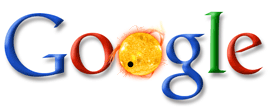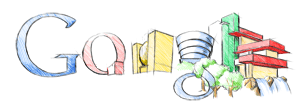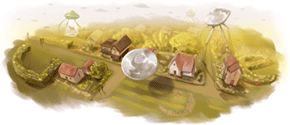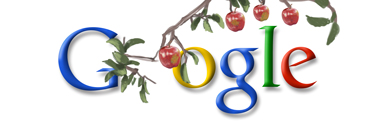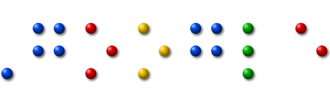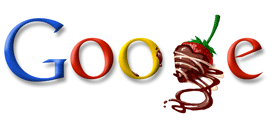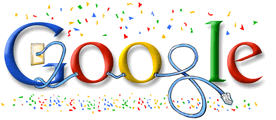Burning Man: Aug. 30, 1998
Google's first doodle was a spur of the moment idea by Google founders, Larry Page and Sergey Brin. Today, Google logo doodles, which can be anything from a quick reaction to a news item to the anniversary of a scientific discovery, are so popular that the company hears from hundreds of thousands of users all over the world with suggestions, corrections, or, like one Japanese businessman, with a thanks "for bringing a small smile to my face every single day." Here, Dennis Hwang, Webmaster Manager, and Micheal Lopez, Senior Web Designer, share the stories behind a few notable doodles.
"Our first doodle went up when Larry and Sergey were running Google while it was in beta on their own," says Hwang. "It shows the Burning Man symbol, the annual alternative festival, which they like to go to whenever they can. They wanted to let the early Google search engine users know that the site would be running unattended while they were there. So they put this up—it's like a fun 'out of office' message."
"It was so popular they did one for Thanksgiving. In the early years, it was a controversial thing to do. If you read any kind of corporate marketing or branding textbook, the one thing they tell you is to make your corporate branding consistent no matter what. But Larry and Sergey said, 'Why not? We should have fun with this.' They did it in spite of some resistance within the company."
Venus Transit: June 8, 2004
"Some of the ideas actually come from our users," says Hwang. "We got an email from a French astronomer who said we would be able to see the planet Venus crossing the face of the sun. We asked him when it was happening, he said 'tomorrow." We told him we didn't know if we could do it on such short notice. He replied, 'well, the next pair of transits is 122 years from now.' So in less than 24 hours we had a design up all around the world. People could see a black dot that would slowly move around the sun."
Frank Lloyd Wright: June 8, 2005
"To do the doodles we do a lot of research—we read, look at a lot of clips—we don't want to get anything wrong," says Hwang. "For Wright's birthday, this logo features works designed by him, including Fallingwater and the Guggenheim. But for the O, while it was loosely based on a building he did design, I had to take some artistic license. When the logo went live, architects around the world went on this chase to find this lost, unseen work by Wright. I felt so bad, we don't want to mislead the public! Every time you do one of these, you learn something."
H.G. Wells: Sept. 5 -21, 2009
"This three-part series to celebrate H.G. Wells' birthday was pretty special for us, says Lopez. "We're all big fans of all things science, and H.G. Wells is one of the greatest science fiction writers of all time. So while we wanted to honor him, we thought, 'why not take it a step further?' Orson Welles did a radio play version of The War of the Worlds that gave listeners the mistaken impression that aliens were invading. We wanted to create a similar stir on the internet.
"So the first doodle we posted was a flying saucer, and we tweeted 'All your O are belong to us,' because the craft was taking away the O. If you're a geek on the internet you know it's a reference to a poorly translated Japanese game.
"Then the second we did these crop circles. And we tweeted the coordinates of the longitude and latitude of where Wells' aliens landed. By this time there were all these theories floating around on the internet—everything from 'Google's donated an O to a non-profit organization,' to 'Google's discovered that there actually were aliens.'
"The last doodle, posted on Wells' birthday, lets everyone in on the joke—we were just celebrating H.G. Wells."
LEGO: Jan. 28, 2008
"In the early days Larry and Sergey used to build hard drive enclosures out of LEGO blocks—it was half fun, half functional," says Hwang. So when LEGO hit their 50th anniversary, it was a natural fit for us. We actually poured a bunch of LEGOs on the floor and built the logo out of LEGO in real life to figure out how to illustrate it correctly."
Isaac Newton's Birthday: Jan. 4, 2010
"This is the very first animated doodle that we've done," says Lopez. "It's based on the famous story on how Newton came up with the theory of gravity—that was inspired by an apple falling. The only way we could to it justice, to give our customers the feeling of surprise that Newton felt, was to make the apple fall in the doodle. So in the animation an apple drops in the middle of the page, and bounces a couple of times. We had a lot of fun developing in our geeky way—it's all JavaScript and code, not Flash."
DNA: April 25, 2003
"Because we like to associate our brand with discovery and technology, it was a natural fit to do this for the 50th anniversary of Dr. James Watson discovering the structure of DNA," says Hwang. "In the original doodle, the helix were not crossing over correctly. Within minutes of posting it we started getting emails and calls from around the world from geneticists saying 'THIS IS NOT A DOUBLE HELIX,' 'URGENT!' It took me awhile to figure out they were talking about this tiny, tiny colored bar. We quickly fixed it and re-launched the doodle and the emails immediately changed to 'thank you so much!'"
Louis Braille's Birthday: Jan. 4, 2006
"We were able to catch a mistake on this one before it went live, thanks to one of our staff. When I sent the original draft around the company, one our engineers told me I had a typo. I was really confident I had been careful, so I asked him how he knew and he said, 'well, I'm blind.' He was able to see the mistake—an extra dot on each of the Os—because he still had 1% of his sight remaining. I was so grateful that he was able to catch that."
"It's always amazing to know a simple doodle can have an impact. After this went up a Canadian non-profit supporting the visually impaired wrote us to say just because of our doodle, web traffic to their website increased by ten-fold."
Valentine's Day: Feb. 14, 2007
"It was a design decision," says Hwang "to have the strawberry represent the G and the stem represent the L. But I guess the stem was too short and people didn't make the connection. I was getting phone calls in the middle of the night after it went up saying we forgot the L. So I knew it was going to be a long day."
"The connections our users came up with to figure out the meaning of the missing L were amazing—things I wouldn't have thought of in my wildest dreams—like it was a tribute to the 16th century poet Barnabe Googe. Apparently he wrote quite often about unrequited love. Some made a connection to a bassist Debbie Googe, part of My Bloody Valentine. So many theories were going around that we had to put out an official company blog post to users telling them that the stem was the L."
New Year's Day and 25 Years of TCP/IP: Jan. 1, 2008
"One of the key internet anniversaries fell on January 1st, the invention of TCP/IP—a set of communications protocols that powers the internet—and since we traditionally do a New Year's doodle," says Hwang, "we were struggling to come up with a design that could work for both. We finally embedded a hidden message in the confetti 'SYN SYN/ACK and ACK' which any network engineer will recognize."
[via TIME]
skip to main |
skip to sidebar
Popular Posts
-
Гугл ты лапочка Я всегда оказываю в Сети публицистическую поддержку талантливым творческим личностям, гугл ты лапочка которым без неё прих...
-
Pacman is taking over Google! The iconic arcade game celebrates its 30th anniversary on May 22, and Google has created a one-of-a-kind Pacma...
-
Google logo - Oktoberfest 2009 Oktoberfest is a sixteen-day festival held each year in Munich, Germany during late September (and running to...
-
Source: http://www.google.com/logos/2011/battuta11-hp.jpg Hajji Abu Abdullah Muhammad Ibn Battuta (Arabic: أبو عبد الله محمد ابن بطوطة), ...
-
Source: http://www.google.com/logos/saminationalday10-hp.gif The Sami National Day falls on February 6 as this date was when the first Sámi ...
-
In Bulgaria it is celebrated on 24 May and is known as the "Bulgarian Education and Culture, and Slavonic Literature Day" (Bulgari...
-
Source: http://www.google.com/logos/confuciussp09.gif Confucius (Chinese: 孔子; pinyin: Kǒng zǐ; Wade–Giles: K'ung-tzu, or Chinese: 孔夫子; ...
Blog Archive
-
▼
2010
(349)
-
▼
November
(82)
- Romania National Day
- St. Andrew's Day
- Doodle 4 Google Japan
- Panama Independence Day
- Bruce Lee's Birthday
- Happy Teacher's Day
- Pippi Longstocking's 65th Birthday
- Wera Engels photo pic
- Wendy Williams photo pic
- Whitney Blake photo pic
- Weronika Rosati photo pic
- Whitney Port photo pic
- Whitney Houston photo pic
- Whitney Duncan photo pic
- Willa Ford photo pic
- Whoopi Goldberg photo pic
- Winnie Hollman photo pic
- Winifred Wagner photo pic
- Willeke Alberti photo pic
- Winona Ryder photo pic
- Winnie Lightner photo pic
- Ximena Duque photo pic
- Wynonna Judd photo pic
- Yana Cova photo pic
- Yamila Diaz photo pic
- Xuxa Meneghel photo pic
- Yasmin Martinez photo pic
- Yasmin Khan photo pic
- Yoko Ono photo pic
- Yasmine Bleeth photo pic
- Yolanthe Cabau van Kasbergen photo pic
- Yolande Donlan photo pic
- Yvette Dugay photo pic
- Yulia Volkova photo pic
- Nikolai Pirogov's Birthday
- Teacher's Day
- Happy Thanksgiving
- Yvette Nacer photo pic
- Yvette Prieto photo pic
- Yvette Nelson photo pic
- Yvonne Craig photo pic
- Yvonne Ameche photo pic
- Yvette Vickers photo pic
- Yvonne Doughty photo pic
- Yvonne De Carlo photo pic
- Yvonne King photo pic
- Yvonne Kicker photo pic
- Zelma O`Neal photo pic
- Zasu Pitts photo pic
- Yvonne Printemps photo pic
- Zhang Ziyi photo pic
- Zeta Graff photo pic
- Ziva Rodann photo pic
- Zhao Wei photo pic
- Zoe Ball photo pic
- Zizi Jeanmaire photo pic
- Zoe Lund photo pic
- Zoe Kravitz photo pic
- Zooey Deschanel photo pic
- Zoe Myers photo pic
- Zora Hurston photo pic
- Zsa Zsa Gabor photo pic
- Happy Birthday to Manuel de Falla
- Happy Thanksgiving
- Labour Thanksgiving Day
- Lebanon Independence Day
- Loy Krathong Festival
- Children's Day
- Teacher's Day
- Morocco Independence Day
- Doodle 4 Google India Winner / Children's Day
- Father's Day
- Taha Hussein's birthday
- Robert Louis Stevenson's 160th Birthday
- Sun Yat-sen's birthday
- Veteran's Day
- Remembrance Day
- Poland Independence Day
- The Story of Google Doodles
- 115th Anniversary of the Discovery of X-rays
- Day of the Dead
- Melbourne Cup
-
▼
November
(82)

